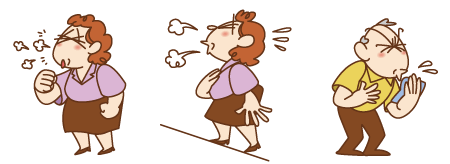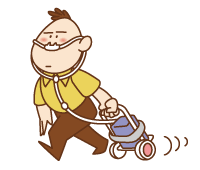Here's the text.
What happens when I smoke?
Last Updated March 7, 2019
There are many diseases that are said to be related to smoking, of which the most serious diseases are cancer, chronic obstructive pulmonary disease (COPD), and heart and vascular disorders (myocardial infarction and angina) ".
Cancer

Tobacco contains a large number of both carcinogens and carcinogens, making it more likely to develop not only lung cancer but also various cancers. Especially for lung cancer, both mortality and disease rates of smokers are very high. Of lung cancer, squamous cell carcinoma has an incidence of more than 21 times that of non-smokers, and adenocarcinoma increases 2.38 times when the number of smokes per day x years of smoking" exceeds 600.
In 2002, the World Health Organization (WHO) International Cancer Research Organization (IARC) assessed the carcinogenicity of smoking and tobacco smoke against humans based on the latest data. Among them, smoking and tobacco smoke are determined to be the strongest "Group 1: carcinogenic to humans". The table below shows the results of this evaluation by cancer type.
Evaluation of "Smoking and Tobacco Smoke" by the International Institute for Cancer (IARC)
※Overall, it is determined as "Group 1: Human being carcinogenic."
| Cancer species | Impact of smoking | ||
|---|---|---|---|
| Causal relationship Presence or absence | Duration, number, etc. Effect of impact | Others (by organization type, etc.) | |
| Oral cavity | ◎ | Oh | Combined with alcohol makes the risk even higher |
| The nasal cavity Paranasal sinus | ◎ | Oh | The association is also found to be associated with tissue type (squamous cell carcinoma). |
| Oropharynx Hypopharyngeal | ◎ | Oh | - |
| Esophagus | ◎ | Oh | By histology type (denocarcinoma, squamous cell carcinoma). |
| Stomach | ◎ | Oh | Excluding the effects of alcohol and H. pylori, smoking has an effect on smoking. |
| Liver | ◎ | Oh | Excluding the effects of hepatitis virus, smoking is also affected. |
| Pancreas | ◎ | Oh | Excluding the effects of alcohol, smoking is also the effect of smoking. |
| Pharyngeal | ◎ | Oh | Combined with alcohol makes the risk even higher |
| Lungs | ◎ | Oh | The association is also found to be associated with cancer by histological type (squamous cell carcinoma, small cell cancer, adenocarcinoma, and large cell cancer). |
| Cervical | ◎ | Oh | Excluding the effects of papillomavirus, smoking is also affected. |
| Urinary tract | ◎ | Oh | It is associated not only with transitional epithelial carcinoma, but also renal cell cancer. |
| Leukemia | ◎(myeloid) | Oh | For lymphatic leukemia and lymphoma, there are few studies reports and results are not consistent. |
(Related or not)
◎: ○ There is a causal relationship ○ It is related to risk increase (impact due to period, number, etc.) ○: The longer the period, the larger the number, the higher the risk
Document: Monographs of Carcinogenic Risk Assessment for Human Carcinogenic Risks, Vol. 83 (2002)
Chronic obstructive pulmonary disease (COPD)
Chronic obstructive pulmonary disease (COPD) is a general term for diseases in which the airway becomes obstructed for a long period of time.
When you smoke a cigarette, the inhaled toxins cause an immune reaction, resulting in a condition that the airway is closed due to excrement, such as an increasing amount of sputum.
There are symptoms of coughing with sputum, shortness of breath lasting for years, prolonged exhale, and symptom. In severe cases, it involves weight loss and thinness, pneumothorax, heart failure or respiratory failure.


After a long course, tissues such as the respiratory tract and alveoli have been destroyed in the first place, and the obstruction of the respiratory tract due to sputum, etc., it is easy to lead to progression to pneumonia, etc., and also climb stairs and slopes. Exercise in a little daily life, such as climbing out, shortness of breath comes out. In the case of severe illness, it is necessary to replenish oxygen using a portable oxygen cylinder.
Typical diseases: emphysema
A emphysema is a disease in which the respiratory tract zodiac and alveoli expand and destroy it. Lungs are an important place for oxygen and carbon dioxide gas exchange, but when exposed to prolonged smoking or inflammation, this gas exchange cannot be performed efficiently. The cause of emphysema is unknown, but most patients with emphysema have been reported to smokers more than 20 people a day and smokers for more than 20 years.
Emphasis has few symptoms that can be called a precursor, and symptoms appear after the alveocle destruction progresses considerably. As a consciousness, you will feel shortness of breath and breathlessness when you move your body. After that, the contours may protrude back and forth, walking on the flat ground at your own pace, or even if you are resting. As emphysema progresses, it requires home oxygen (a condition in which oxygen inhalation is required in daily life).
Cardiovascular disorders
The effects of nicotine and carbon monoxide contained in cigarettes make it more susceptible to heart and blood vessels.
Nicotine causes an increase in heart rate, contract peripheral vascular contract, and increases blood pressure, and damages blood vessels. It can lead to increased blood pressure, increased burden on the heart and blood vessels, and increased viscosity in the blood (the blood becomes muddy), making cardiovascular disorders more likely to occur.
In addition, the action of nicotine deteriorates LDL cholesterol and makes it easier to penetrate the arterial wall.
For inquiries to this page
Health Promotion Division, Health and Social Welfare Bureau Health Promotion Department
Phone: 045-671-2454
Phone: 045-671-2454
Fax: 045-663-4469
Email address: kf-kenkosuishin@city.yokohama.jp
Page ID: 882-389-199







